
Community Tax Lawsuit Update for Tulalip Tribal Membership

syəcəb


By Kalvin Valdillez, Tulalip News
If you spent this past holiday season reflecting on the last ten years while scarfing down a carb-loaded plate of leftovers and vowing to make personal changes after the last second of 2019 ticked, you are definitely not alone. Now more than ever, people nationwide are practicing better organization skills, picking up new hobbies, reading more books, setting higher goals and planning a brighter future. For many, the new calendar year marks a fresh start, and during this phase people take the time to give much-needed attention to certain areas of their life that they’ve been neglecting.
Perhaps the most shared new year resolution globally is the desire to better one’s health. And as a result, the produce sections at the local grocer are often overcrowded as are thousands of gyms across the country. But more often than not, as the weeks pass by, people start to give in to their old habits and give up on their goals of self-development and personal growth. Staying true to your resolution weeks down the road after the ‘new year, new me’ adage loses its luster is a difficult task to say the least. For this reason, AnneCherise Jensen of the Tulalip SNAP-Ed program took some time to offer a few tips and advice to those beginning their new health and fitness journey in 2020.
We made it to a new decade! Let’s begin by talking about the importance of fueling up with proper nutrition and treating our bodies with respect.
Our bodies are a gift we’ve been given by the creator that carries our mental being; our spiritual side and physical side. It holds our heart, our mind, our love and compassion. Everything that we feel, do and think – it all stems from our body. In order for us to thrive as human individuals, we should respect our body and know that everything that we put into it is either feeding disease or fighting disease.
Where is a good place to start for those who are setting out on their first quest for overall better health?
A first good step is to start cutting out the bad foods. Think about the most-unhealthy things that you’re consuming and try to taper away from those foods and drinks. If you’re ordering really sugary beverages every day, that have about ten pumps of syrup, work on slowly reducing it down to two pumps or learn how to make your own syrups. This past weekend I made a homemade elderberry syrup and added it to sparkling water; it was sweet, tasty and still really healthy.
Also, try to cut back from the unhealthy foods like salts and fat and slowly supplement the bad foods with healthy foods. If you’re eating one serving of fruits or vegetables a day, try to up it two.
Any tips on how to incorporate more greens and fruits into your everyday diet?
Don’t be lazy and cook, number one rule. Meal prep ahead of time, buy vegetables and don’t let them sit in your fridge. Cut them up in half and roast them and have them ready to go for the week. Same with fruit. Have those foods around and available in your house, and learn how to utilize them; prepare snack trays for the kids after school, add more veggies to your everyday foods. Like with your pasta, you can add mushrooms, onions, peppers, garlic. You can cook big batch dinners, just throw all your vegetables into your crock pots or Instapots.
Find out what foods your family enjoys and stick to those so that way you’re not wasting your money on food your family is not going to eat. Start with the foods you know people are going to like, find easy recipes that are going to help you make those foods manageable so they actually fit into your diet and then slowly branch off that and try new foods as you go.
With the popularity of the Impossible Burger and Beyond Meat burger on the rise, many are experimenting with meatless meals. Any advice for people curious about switching to a plant-based diet?
If you’re going meatless, avoid the meatless burgers at fast food restaurants. Those are full of artificial hormones. The food at fast food establishments, especially McDonalds and Burger King, contain some of the highest carcinogens, or cancer causing agents. They also cause a lot of inflammation as well.
It honestly depends on how much protein you need. There are a lot of good plant substitutes for proteins, especially beans, legumes, almonds. As long as you’re getting adequate amounts of protein, that’s great. But I would highly discourage you from eating the vegetarian burgers from the fast food joints.
A lot of people, especially Natives, are in fact returning to the diets of their ancestors; wild game, native plants and fish. What are your thoughts on the traditional diet?
I think going back to the traditional diet is amazing, it’s something that I’ve been practicing myself. Over the winter break I harvested four different kinds of mushrooms and a couple different types of trees and am learning how to make medicine with it. Nature is jam-packed with more medicine than we can ever imagine. I always recommend making your own teas, going and getting cedar from your backyard, letting it dry overnight and making a tea with it. You can do that with pine needles as well. Once the nettles start coming out in a couple weeks, you can make nettle tea. There’s always something you can forage at any given time of the year.
Many health experts encourage people to increase their daily water intake. Why is it important to stay hydrated?
We’re living in a society now where sugary beverages are all around us and it really can be the enemy of our health. Water is good not only for our bodies but for all of our metabolic functions. It helps us digest food, stay awake, stay energized, build muscle mass and rid toxins from our body. As good stewards of the earth, we want to try to avoid plastics as much as we can. Today, we are finding so many chemicals in our water – fluoride, mercury, plastic. So it’s always good for our health to carry a reusable water bottle and have a good water filtration system. For flavor, I like to infuse natural fruits and vegetables like cucumbers, raspberries and strawberries. Frozen fruits are fun, cheaper and add an icy texture. Fruits and vegetables naturally contain a lot of water in them so the more fruits and vegetables you eat; the more water content you’re getting. Try to carry your water bottle with you every day and make it a goal to drink 16-32 oz. of water a day.
Some people are finding it easier to stick to healthy meal plans by including a cheat day once a week. Should people plan out their cheat days in order to see more success?
It really depends on where you’re at with your personal relationship with food. A lot of people are dealing with food disorders and may overeat and over indulge. Or you might be the total opposite and suffer from anorexia. You have to find the right balance and know your relationship with food. If you can control it, give yourself a cheat day where you have a little more forgiveness for yourself and leniency. On the weekends, I’ll eat two servings of pasta and have some desserts those days. It’s always good to not only feed your body, but feed your spirit because you also want to be able to have those foods that make you happy, so its finding that right balance between the good, the bad and healthy moderation.
What are a few fun ways to stay active during these winter months?
If you’re into snow sports, there’s snowboarding and skiing. You can also go snowshoeing as well up in the mountains. We are getting a lot of rain and it’s kind of yucky to be outside, but there’s always the gym. Right now is a great time to go to the gym because you can get a lot of people motivated in your family to go with you. Do some simple chair yoga and desk exercises. Hiking is really fun too. Some trails are open like Lake 22, Heather Lake, those are local. And just take time to walk at the beach and get outside on those days when we have a bit of good weather.
Any last pieces of advice or words of encouragement for those working to attain a healthier lifestyle and stay true to their goals?
Know that we’re all human. We all have those days where you’re literally driving for half the day and all you can do is go to a drive thru. Just get back on track the next day and give yourself forgiveness and grace because we all have days we mess up, but don’t let that discourage you. It’s okay. Don’t be hard on yourself, just try better the next day.
We have to find strategies that work for us and get together as a community, with our family and friends to overcome the easy convenience foods that like to feed disease. We need to go out into nature and reconnect with those foods and work as a team to eat healthier foods.
Tulalip SNAP-Ed regularly hosts a number of classes throughout the year, such as the Eat Smart, Be Healthy course. To stay updated on their upcoming events and classes, be sure to like the Tulalip Food & Nutrition Education Facebook page. And for additional details, please contact the SNAP-Ed program directly at (360) 716-5632.
___________________________________________
Warrior’s Stew

Budget-friendly recipe. A special stew that celebrates the return of successful hunters, this can be made with venison or beef. Serves 6
Ingredients
Directions
Nutrition Info and more
Serving size: 2 cups. Total calories: 275 Total fat: 9.1 g Saturated fat: 3.3 g Carbohydrates: 25.9 g Protein: 24 g Fiber: 5.9 g Sodium: 580 mg
Publication: Young, Indigenous, and Healthy: Recipes Inspired by Native Youth Author: Leah’s Pantry; Source: Leah’s Pantry
______________________________________________________
Frittata

Budget-friendly recipe. Make this on a Sunday so you can heat up leftovers for an easy breakfast throughout the week. Serves 8
Ingredients
Directions
Nutrition Info and more
Serving size: 1 slice. Total calories: 160 Total fats: 7 g Saturated fat: 3 g Carbohydrates: 7 g Protein: 13 g Fiber: 3 g Sodium: 350 mg
Author: Arthur Birnbaum; Source: Share Our Strength’s Cooking Matters

By Micheal Rios, Tulalip News
Educators, parents and others often place strong emphasis on college preparation and earning an Associate’s or Bachelor’s degree by traditional means. But that lengthy and expensive route often means accruing a ton of debt just to enter a highly competitive job market. College degrees may be the preferred goal for many, however there are a growing number of students who see a more hands-on future for themselves. For these individuals, unafraid of getting their hands dirty and learning the true meaning behind a hard day’s work, there is an abundance of opportunity within the construction industry.
Whether it be laborer, carpenter, ironworker, electrician or heavy equipment operator, there are countless positions available for work and advancement within the trades, especially for sought after minorities like Native Americans and women. A major access point for entry into these desirable career paths for tribal citizens and their families continues to be Tulalip’s own TERO Vocational Training Center (TVTC).
“Not everybody wants to be a doctor or lawyer. Not everybody wants a desk job. I’m a lifetime fisherman that started a construction company when it became apparent we could no longer sustain ourselves simply by living off the land,” said Tulalip Vice-Chairman Glen Gobin. “Some want to be outside working with their hands. That’s what brings people to our training program, it gives them an opportunity to get exposure to all the different trades, learn how to function on a job site and how to get work. Graduates of TVTC enter a section of the workforce that is in high demand.”
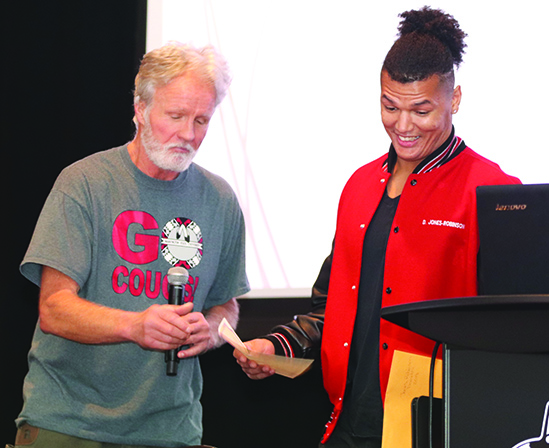
In fact, a quick glance around the greater Seattle area and onlookers are sure to see more cranes than they can count. Along the I-5 corridor, from Tacoma to Everett, construction projects are booming and many on-site jobs continue to go unfilled. While other career pathways may be oversaturated and hard to come by, those within construction trades are thriving. According to the U.S. Department of Labor, open construction positions are expected to increase by more than 700,000 jobs nationally through 2028, a faster growth than any other occupation. In Washington State alone, there are nearly 3,000 unfilled construction jobs that pay much more than the average state wage.
Brighter horizons and prospects galore were among the reasons so many gathered to celebrate the TVTC autumn cohort’s achievement on a December morning at the Tulalip Resort’s orca ballroom. Fifteen students (including eight Tulalip tribal members and three women) were honored with a graduation banquet for their commitment to building a better future. Nearly 200 guests attended, including trade union representatives, several construction employers, and many cheerful family members.
“Our TVTC program is 100% supported by grant funds,” explained TERO director Summer Hammons. “Our TVTC graduates earned various certifications and college credits, while learning many skills that will undoubtedly make an impact on their future. We thank the Tulalip Tribes, Washington State Department of Transportation, Sound Transit, and the Tulalip Cares charitable fund for always supporting us. These organizations and community partners are ensuring our future leaders have viable career paths.”
TVTC is the first and only state and nationally recognized Native American pre-apprenticeship program in the entire country. The program is accredited through South Seattle Community College and Renton Technical College, while all the in-class, hands-on curriculum has been formally approved by the Washington State Apprentice and Training Council.
The sixteen-week program provides 501-hours of hands-on instruction, strength building exercises, and construction skills that can last a lifetime. In addition, students are trained and awarded certifications in flagging, first aid/CPR, industrial fork lift and scissor lift, 40-hour HAZWOPER, and OSHA 10-hour safety.
Homegrown Tulalip citizen Demitri Jones opted to retake the class after not being able to complete it his first time around. To jumpstart an all-new career path as a carpenter, he had to grit and grind. He maintained his full-time position as a security officer working the dreaded graveyard shift, while sacrificing convenience and lots of sleep to take the TVTC class during the day.
“My biggest takeaway is learning the benefits of hard work and dedication,” reflected Demitri. “My advice to those who already have a job but are interested in taking the class, if you really want it then make it happen. Creating a routine was so important, but knowing in the end it’ll all be worth it kept me going.”
His instructors noted he was the first in his class to gain employment. “I’m a carpenter’s apprentice right now and looking forward to journeying out, becoming a foreman or even superintendent,” added the ambitious 26-year-old.
Along with gaining a wide-range of new employment opportunities via the trades, seven diligent students took advantage of the educational aspect and earned their high school diploma.

Three hardworking ladies were among the graduates, Carla Yates (Haida), Cheyenne Frye (Arikara) and Shelbi Strom (Quinault). Each wanted to acquire a new skillset while creating a pathway to a better and brighter future.
“I really liked the class. I met some really cool people and learned so many new skills that I would have never been exposed to if I didn’t try it out,” said 20-year-old Cheyenne. Originally from North Dakota, her family relocated to the area so her mom could take the TVTC program. After graduating and seeing all the opportunity now available to her, she convinced her daughter to follow suit.
“I had zero experience with construction tools, like the nail gun and different saws. All of that was pretty intimidating at first, but after I learned to use them properly it became a lot of fun using them to complete projects,” admitted Cheyenne. “Both my parents have jobs as plumbers on the new casino project now. Hopefully I can join an electricians’ or sheet metal union and get work on that project, too.”
With hundreds of skilled-trade workers retiring every day across the state, the construction industry is in need of the next generation workforce to help build an ever-growing Snohomish County and surrounding Puget Sound communities. In the Seattle-Bellevue-Everett area alone, construction employment increased by 6,400 jobs between March 2018 and March 2019, according to the Associated General Contractors of America. These are well-paying jobs that are available to people straight out of high school. It takes some grit for sure, but for those folks with a strong work ethic and can-do attitude, they can find themselves running a construction company of their own someday.
“When our student graduates go out into the world of construction, they can compete on equal footing with anybody,” declared TVTC instructor Mark Newland during the graduation ceremony. “We’re gaining traction with union companies and construction employers all over the region.
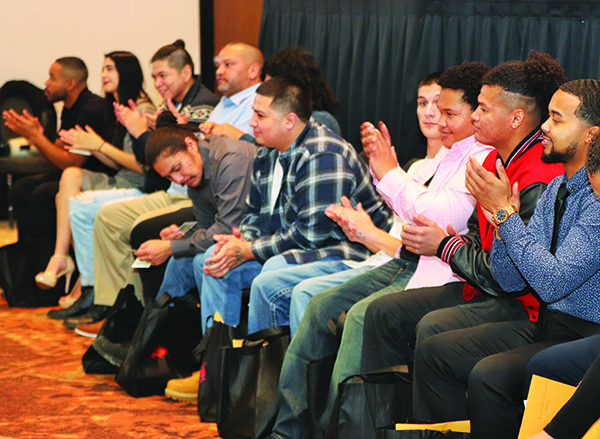
“I just can’t say enough about this class,” he continued. “From day one, they were engaged, helping each other out, and understood what they had to gain by putting their nose to the grindstone. Really amazing stuff! They’ve given me so much as their instructor and I wish them all the best.”
Those interested in being among the next available TVTC cohort or would like more information about the program, please call (360) 716-4760 or email Ltelford@tulaliptribes-nsn.gov
Please use the following link to download the January 11, 2020 issue of the syəcəb

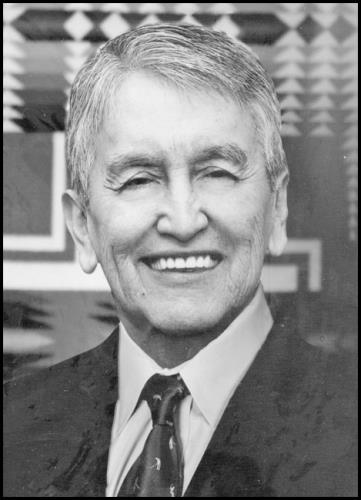
Charles Michael “Chuck” James II Sept. 29, 1941 – Dec. 29, 2019 Charles James was born on September 29, 1941 to Charles and Marjorie James. He passed away on December 29, 2019 surrounded by his loving family. He married the love of his life, Illene, in 1961 and shared 58 years together. Chuck worked for Bethlehem Steel until retirement in 2001; then went on to be the Chief Operating Officer of the Tulalip Resort Casino, his last position was a Tulalip Tribes Board Member. He loved sports. He and his wife have been Seahawks ticket holders since 1976. Chuck played and coached both basketball and baseball. He was a man of steel with his firm handshake, who could still do jump shots in his 70’s. He believed team sports taught life skills, working together to achieve goals and sharing in successes was winning. He was preceded in death by his great-grandson, Marcellus A. Chavez. He is survived by wife, Illene G. (Hatch) James; son, Charles James III; daughter, Charlene James (Ramon Johnny); grandchildren, Tristan James, Madison Johnny (Dennis), Lee Johnny, Maya Johnny-Chavez (Marcel); great-grandchildren, Annabell Lee Johnny, Maryanna Chavez; brothers, Leonard James and Mark James; many nieces and nephews he loved. Recitation of the Rosary was held Thursday, January 2, 2020 at 6:00 p.m. at Tulalip Gym. Funeral services will be Friday, January 3, 2020 at 10:00 a.m. at the Tulalip Gym with burial to follow at the Mission Beach Cemetery.
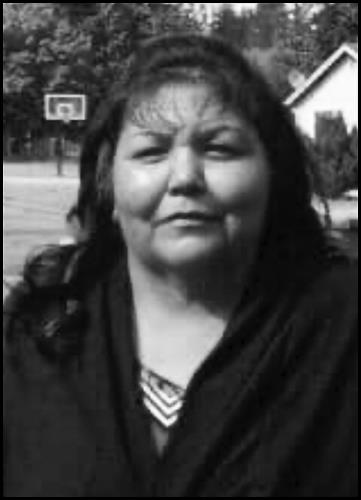
Brenda Moses, 58 of Tulalip, Washington passed away December 23, 2019. She was born November 8, 1961 in Everett, Washington to Alvin and Clarice Moses Sr. She worked at the Bingo Parlor and then at the casino as a table game dealer and pit boss. She enjoyed camping, going to the mountains and enjoyed family gatherings. She like to go blueberry and blackberry picking as well as boating. She was preceded in death by her father, Alvin Moses Sr.; brother, Alvin Moses Jr.; granddaughter, Adrea Elliott; grandson, Michael (Her baby) Brown III and uncle, Delbert Moses, and nephew, Jason Lee Moses. She is survived by her soulmate of 36 years, Tommy; four daughters, Athena (Rob), Aimee, Ateesha (Issac), her baby, Bridget (Nate); her mother, Clarice Moses; sister, Naomi; brother, Brian; grandchildren, Tianna, Alieja, Kyliah, Desean, Kiera, Kathryn, Makhaio, Miniyah; great granddaughter, Aaliyah-Camari; auntie Irene, Charlene, Janice; uncle Neil, as well as other aunties, uncles, nieces, nephews, and cousins. The most important thing to her was spending time with her grandchildren. A visitation will be held Monday, December 30, 2019 at 1:00 pm at Schaefer-Shipman with an Interfaith Service at 6:00 pm at the Tulalip Gym. Funeral Services will be held Tuesday at 10:00 am at the Tulalip Gym with burial to follow at Mission Beach Cemetery.
By Ryan Miller, Environmental Liaison- Program Manager, Tulalip Tribes Treaty Rights Office
No state or local government law can interfere with tribal self-governance or diminish the rights protected by federal treaties.
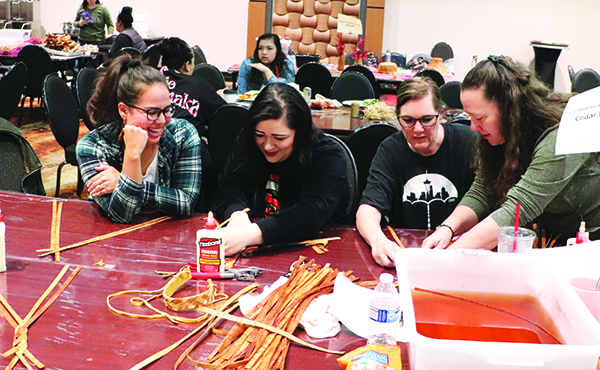
By Cullen Salinas-Zackuse, Tulalip News
On Sunday December 15th, at the Tulalip Resort Casino, fifteen of Tulalip’s cedar weavers came together to teach the community how to weave. They shared their expertise and enjoyed their time teaching traditional ways of making cedar baskets, headbands, dolls, jewelry and many other cedar creations. It was the first time this many Tulalip weavers came together to enrich the community with cultural activity of this nature.
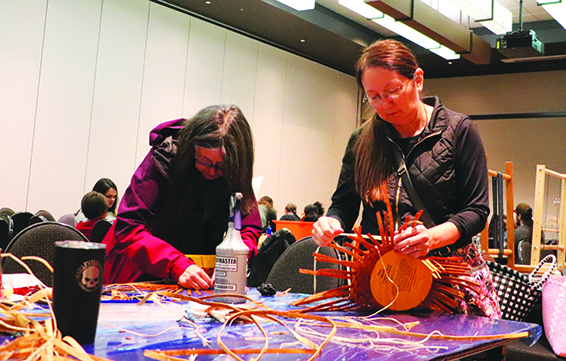
“All the teachers have a lot of teachings and history,” said event coordinator,Virginia Jones, on how the weavers showed the importance of carrying on these skills for all the generations after us.
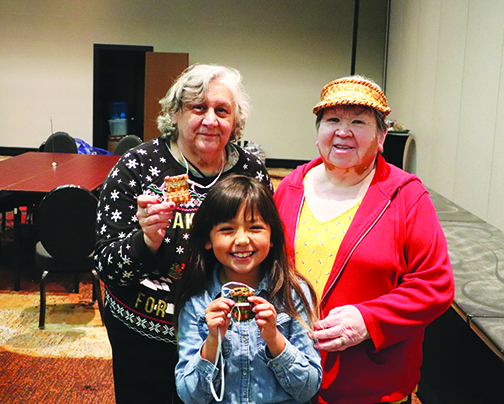
Weaver Clarissa Johnny talked about how she learned from Anna Jefferson (Lummi) how to peel and process the cedar, and how to cure it. “She [Anna] was taught how to respect the forest and pray before taking anything from the cedar tree. Pray before you leave and thank the cedar tree for giving up part of its life for us”.
One of the younger weavers, Shylee Burke, said that she “learned from her aunties and it is passed down from generation to generation”, because she was always around it as a child. It wasn’t until later in life that she said learned how to “put her hands to work,” learning how to weave.
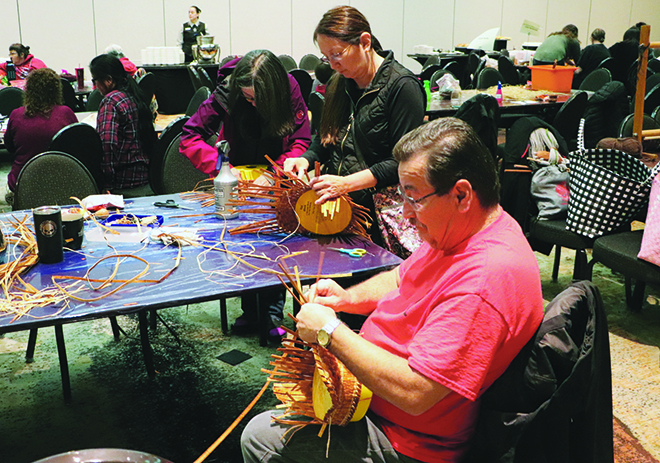
Overall, everyone who attended took away something from this event. Whether it was learning how to carry on the culture or different weaving styles, it was a fun way to come together and share culture with the community.
By Cullen Salinas-Zackuse, Tulalip News
When getting awards in academia, typically what people think of is a straight edge, hard working kid that worries about grades and school comes to them effortlessly. Not all students function the same way, some shine differently. When going through the rigorous journey of school these kids did not have the typical ride and with their resilience and efforts they were able to endure their situation and succeed. This semester these are the Native youth that were nominated and recognized for the outstanding work and efforts.
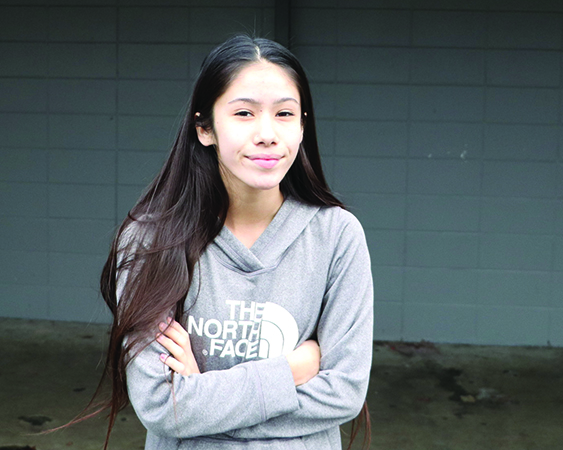
The student of the semester for middle school is 8th grader Lenay Chuckalnaskit. She recently moved from Nespelem Washington, to Marysville and now attends Totem Middle School. She was noticed for her hard work while going through a tough transitional phase in life with friends, grades, and a good attitude. She became a student athlete and participates in track and field 100-meter dash/hurdles, volleyball, and gymnastics. Lenay also participates in the cultural activities by Powwow dancing. With all the activities Lanay is doing she is also able to maintain a 4.0 GPA, as she is driven and has only missed two days of school this year.
Lanay eventually wants to have a career in the medical field but is not positive where yet. She thanks her parents and family for supporting her along her academic journey. She also looks up to her 19-year-old sister for being her role model and leading by example on how to be successful in school.

The student of the semester for high school was nominated because of his growth as a student. Tristian Hopkins is a senior at Marysville-Getchell High School. He started his high school career at Tulalip Heritage, where he felt comfortable going to school with friends and family. He eventually felt distracted and wanted to branch out and explore a bigger school and that is where he found himself at Marysville-Getchell Highschool. Going from 100 kids who are friends and family to a school that has 1,500 kids usually seems like a tough transition but Tristian looked at it as an opportunity for growth. He was able to find a new crowd and focus better in his academic work. He pulled his grades up to above a 3.0 GPA, but not without sacrificing a year playing football. Choosing to focus on school over football did not diminish his love for the game. His senior year he came back and played for the varsity football team. Tristian was able to rack up 8 tackles his last 3 games and was honorary captain for a couple of those games.
Looking to the future, Tristian plans on applying to Arizona State University. He wants to become an aerospace engineer and work on building airplane parts. It makes sense when you ask him his favorite subject, he says physics. Academic careers hardly ever go as planned and not all are perfect, but along the journey there is always room to grow. That is what Tristian showed he can do.
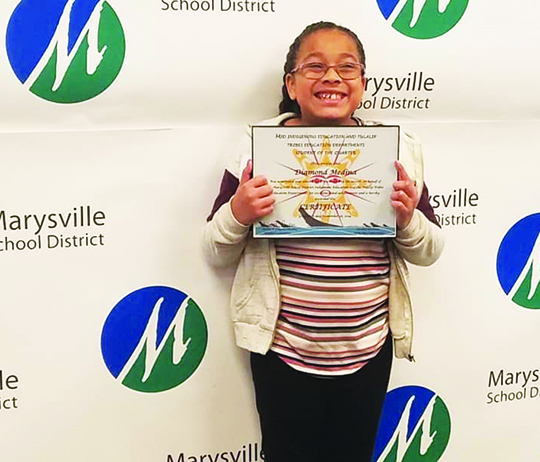
Diamond Medina is a sweet, kind young lady. She a fifth grader at Tulalip/Quil Ceda Elementary where she has grown into a positive role model. She always stays focused and gets her work done. Multiple teachers noticed she is organized and advocates for herself and her learning. Diamond doesn’t get distracted easily as she’s always on time for her groups and utilizes her resources while she is in school. Overall, she keeps her positive mindset no matter her situation at school and is always smiling.
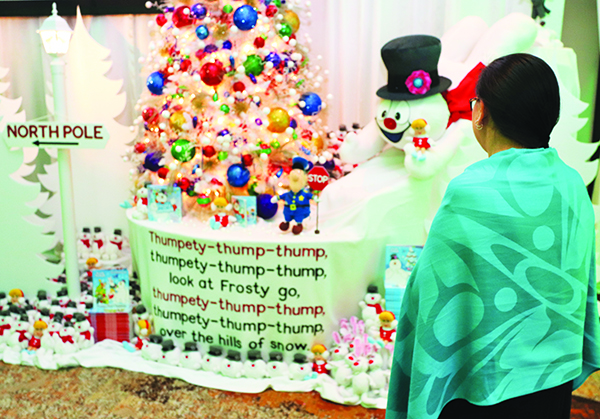
By Micheal Rios, Tulalip News
Extravagantly festive Christmas trees and wreaths, each decorated with its own unique theme and style, brightened the Orca Ballroom at the Tulalip Resort Casino during the 34th annual Festival of Trees. The week-long celebration kicked off December 3rd with opening night festivities, continued with the excitement-filled Gala Dinner and Live Auction on December 6th, and concluded December 7th with the family friendly Teddy Bear Breakfast.
Each year, thousands of community members take part in the Festival of Trees – including volunteers, sponsors, and attendees – to raise funds for Children’s Services at Providence Regional Medical Center in Everett. For more than three decades, Providence Children’s Center has been providing comprehensive, family-oriented care and highly specialized therapies – such as physical, occupational, speech and feeding therapy – for children with a wide variety of special needs.
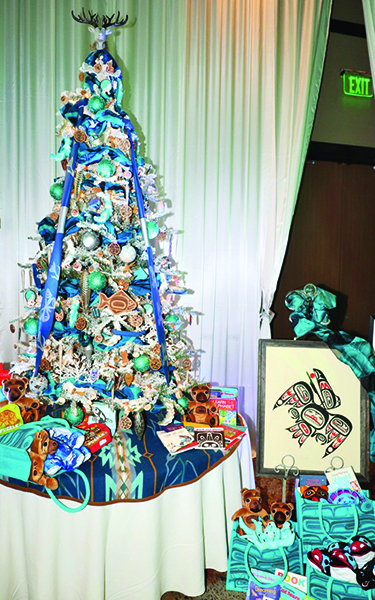
“Knowing this is one of the largest charitable events for Snohomish County, it is appropriate for us to host and participate with goodwill and sharing the opportunity to help all children in need,” explained Marilyn Sheldon, manager of Tulalip Tribes Charitable Fund, on the importance of hosting the Festival and being the title sponsor. “We recognize that over 50% of Tulalip’s population is 0-24 years of age and Providence is our local hospital for care most tribal members use for emergency situations and other needs. Also, this event brings many people to our facilities for the week and encourages them to come back and host their own business/charity event at our venue.”
A highlight of the holiday season, the Festival of Trees provides entertainment for countless families and children. Whether it’s a black-tie evening with a three-course dinner or a free afternoon with cookies and Santa, the Festival’s variety of events offer holiday cheer for all kinds of crowds. The stunningly decorated Christmas trees won’t soon be forgotten as their specialized themes like ‘Merry Christmas from Mickey Mouse’ and ‘Christmas Under the Sea’ to ‘Arctic Winter Dreams’ and ‘A Celebration of Tulalip Culture’ capture the imagination.

During the elegant gala dinner and live auction, the dazzling Christmas trees and wreaths were sold to the highest bidders, with proceeds going to Providence Children’s Services. Several of the trees were reserved to be put on display throughout the Children’s Center as a special treat for hospitalized kids this holiday season.
“For more than three decades, this fun-filled, weeklong series of events has raised more than $12 million dollars to support the healthcare needs of children in our community,” stated Festival Chairs, Scott and Kippy Murphy. “Over the years, we have been in awe of the generosity shown at this event and it is that spirit of generosity and collective effort of our community that inspired us to choose this year’s theme – Season of Miracles.”
The generosity of countless donors and Festival attendees supports Providence in growing and expanding specialized therapies, equipment and educational classes that really does make miracles happen for children and families at Providence every day. Total monies raised this year topped $1.2 million, with all funds going directly to Providence programs and services such as Pediatrics, the Newborn Intensive Care Unit, the Children’s Center, the Autism Center, and Camp Prov, a summer camp for children with special needs.

For nearly two decades, Tulalip Tribes has been an important partner to Providence in the Northwest Washington Region, by helping provide the funding and support needs to care for the health of our growing community. Contributions made by Tulalip to Providence General Foundation since 2002 have totaled more than $750,000. For their dedication to the Festival of Trees, the Tulalip Tribes were honored with the Spirit of Festival Award at last year’s Gala and live-auction.
“The lives of thousands of children, that includes Tulalip tribal children, will be helped thanks to the generosity received from the Festival of Trees fundraising efforts,” said Board of Director Mel Sheldon, fourteen-year member of the Providence General Foundation. “We are very fortunate to have a relationship with Providence Medical Center and to support such an amazing opportunity that really looks at the bigger picture. We all want to do our part to create a sustainable and healthy community.”

One of Snohomish County’s largest and most well attended holiday events, the Festival of Trees has been a beloved community tradition for 34 years. The annual outpouring of community spirit, combined with a magical setting, delivered a wonderful event that united many during the holiday season.